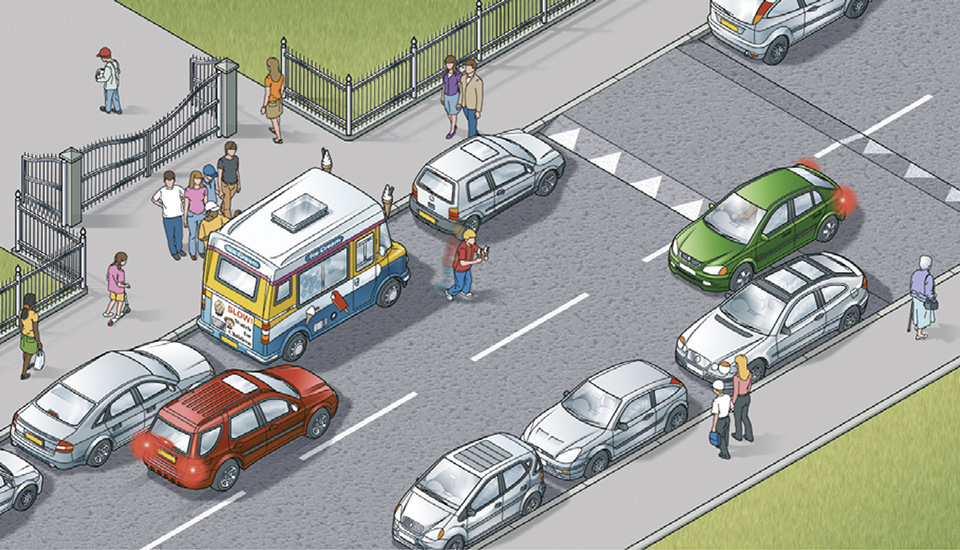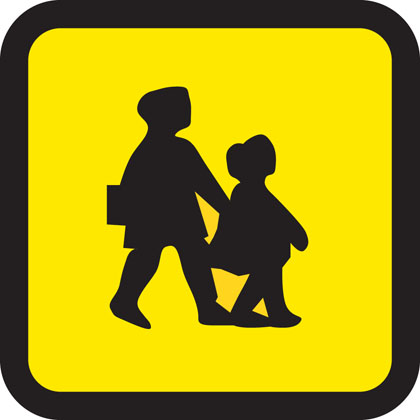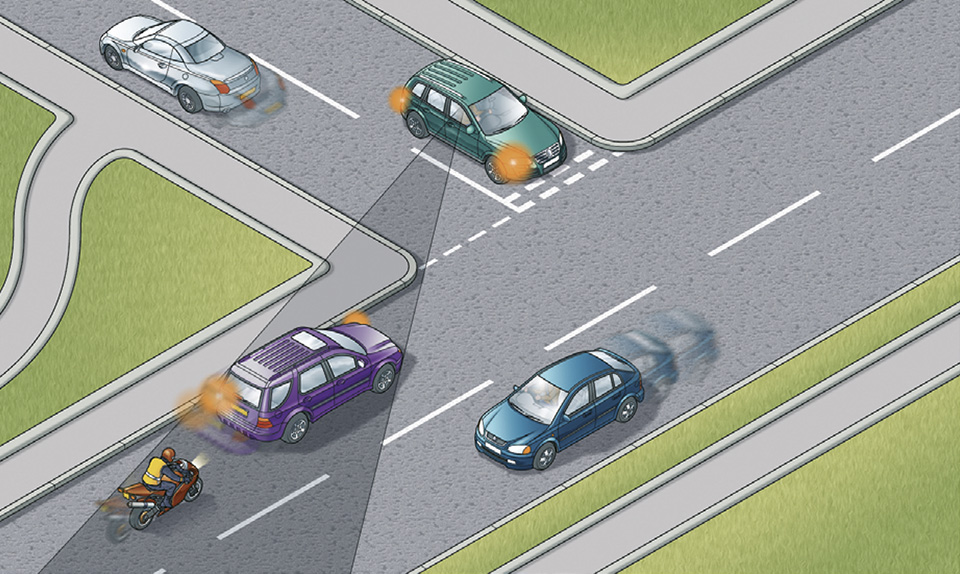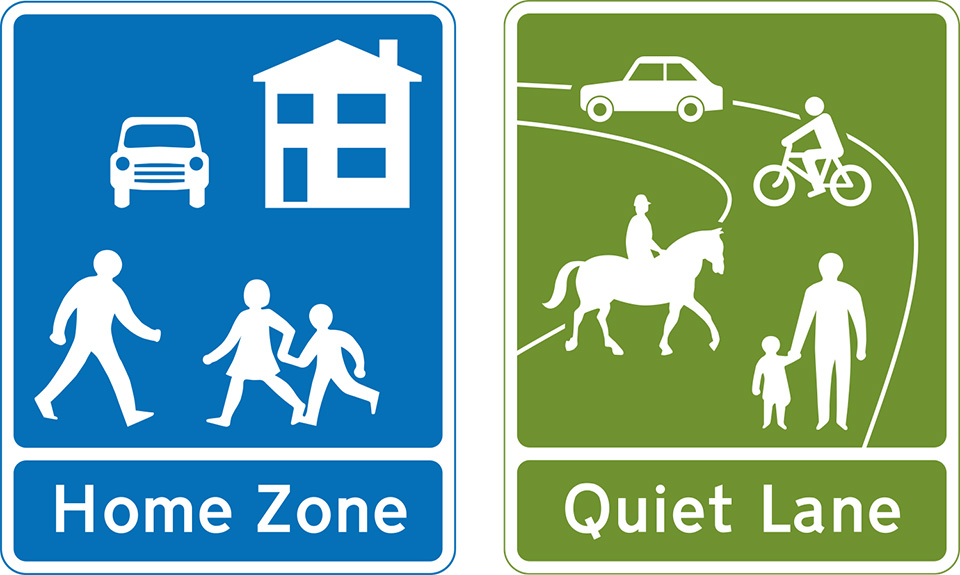Highway Code Rule 204
The road users most at risk from road traffic are pedestrians, in particular children, older adults and disabled people, cyclists, horse riders and motorcyclists. It is particularly important to be aware of children, older adults and disabled people, and learner and inexperienced drivers and riders. In any interaction between road users, those who can cause the greatest harm have the greatest responsibility to reduce the danger or threat they pose to others.
Highway Code Rule 205
There is a risk of pedestrians, especially children, stepping unexpectedly into the road. You should drive with the safety of children in mind at a speed suitable for the conditions.
Highway Code Rule 206
Drive carefully and slowly when
- in crowded shopping streets, Home Zones and Quiet Lanes (see Rule 218) or residential areas
- driving past bus and tram stops; pedestrians may emerge suddenly into the road
- passing parked vehicles, especially ice cream vans; children are more interested in ice cream than traffic and may run into the road unexpectedly
- needing to cross a pavement, cycle lane or cycle track; for example, to reach or leave a driveway or private access. Give way to pedestrians on the pavement and cyclists using a cycle lane or cycle track
- reversing into a side road; look all around the vehicle and give way to any pedestrians who may be crossing the road
- turning at road junctions; you should give way to pedestrians who are crossing or waiting to cross the road into which or from which you are turning
- going through road works or when passing roadside rescue and recovery vehicles, as there may be people working in or at the side of the road
- the pavement is closed due to street repairs and pedestrians are directed to use the road
- approaching pedestrians on narrow rural roads without a footway or footpath. Always slow down and be prepared to stop if necessary, giving them plenty of room as you drive past
- approaching zebra and parallel crossings as you MUST give way to pedestrians and cyclists on the crossing (see Rule 195)
- approaching pedestrians who have started to cross the road ahead of you. They have priority when crossing at a junction or side road so you should give way (see Rule H2).
Law
Highway Code Rule 207
Particularly vulnerable pedestrians. These include:
- children and older pedestrians who may not be able to judge your speed and could step into the road in front of you. At 40 mph (64 km/h) your vehicle will probably kill any pedestrians it hits. At 20 mph (32 km/h) there is only a 1 in 20 chance of the pedestrian being killed. So kill your speed
- older pedestrians who may need more time to cross the road. Be patient and allow them to cross in their own time. Do not hurry them by revving your engine or edging forward
- people with disabilities. People with hearing impairments may not be aware of your vehicle approaching. Those with walking difficulties require more time
- blind or partially sighted people, who may be carrying a white cane using a guide dog. They may not be able to see you approaching
- deafblind people who may be carrying a white cane with a red band or using a dog with a red and white harness. They may not see or hear instructions or signals.
Highway Code Rule 208
Near schools. Drive slowly and be particularly aware of young cyclists and pedestrians. In some places, there may be a flashing amber signal below the ‘School’ warning sign which tells you that there may be children crossing the road ahead. Drive very slowly until you are clear of the area.
Highway Code Rule 209
Drive carefully and slowly when passing a stationary bus showing a ‘School Bus’ sign as children may be getting on or off.
Highway Code Rule 210
You MUST stop when a school crossing patrol shows a ‘Stop for children’ sign (see ‘Signals by authorised persons‘ and ‘Traffic signs‘).
Law
Highway Code Rule 211
It is often difficult to see motorcyclists and cyclists, especially when they are waiting alongside you, coming up from behind, coming out of or moving off from junctions, at roundabouts, overtaking you or filtering through traffic. Always look out for them before you emerge from a junction; they could be approaching faster than you think.
Do not turn at a junction if to do so would cause the cyclist going straight ahead to stop or swerve, just as you would do with a motor vehicle.
When turning right across a line of slow-moving or stationary traffic, look out for and give way to cyclists or motorcyclists on the inside of the traffic you are crossing. Be especially careful when moving off, turning, and when changing direction or lane. Be sure to check mirrors and blind spots carefully.
Highway Code Rule 212
Give motorcyclists, cyclists, horse riders, horse drawn vehicles and pedestrians walking in the road (for example, where there is no pavement), at least as much room as you would when overtaking a car (see Rules 162 to 167). Drivers should take extra care and give more space when overtaking motorcyclists, cyclists, horse riders, horse drawn vehicles and pedestrians in bad weather (including high winds) and at night. If the rider looks over their shoulder it could mean that they intend to pull out, turn right or change direction. Give them time and space to do so.
Highway Code Rule 213
On narrow sections of road, on quiet roads or streets, at road junctions and in slower-moving traffic, cyclists may sometimes ride in the centre of the lane, rather than towards the side of the road. It can be safer for groups of cyclists to ride two abreast in these situations. Allow them to do so for their own safety, to ensure they can see and be seen. Cyclists are also advised to ride at least a door’s width or 1 metre from parked cars for their own safety.
On narrow sections of road, horse riders may ride in the centre of the lane. Allow them to do so for their own safety to ensure they can see and be seen.
Motorcyclists, cyclists, horse riders and horse drawn vehicles may suddenly need to avoid uneven road surfaces and obstacles such as drain covers or oily, wet or icy patches on the road. Give them plenty of room and pay particular attention to any sudden change of direction they may have to make.
Highway Code Rule 214
Animals. When passing animals, drive slowly. Give them plenty of room and be ready to stop. Do not scare animals by sounding your horn, revving your engine or accelerating rapidly once you have passed them. Look out for animals being led, driven or ridden on the road and take extra care. Keep your speed down at bends and on narrow country roads. If a road is blocked by a herd of animals, stop and switch off your engine until they have left the road. Watch out for animals on unfenced roads.
Highway Code Rule 215
Horse riders and horse-drawn vehicles. Be particularly careful of horse riders and horse-drawn vehicles especially when approaching, overtaking, passing or moving away. Always pass wide and slowly. When you see a horse on a road, you should slow down to a maximum of 10 mph. Be patient, do not sound your horn or rev your engine. When safe to do so, pass wide and slow, allowing at least 2 metres of space.
Feral or semi feral ponies found in areas such as the New Forest, Exmoor and Dartmoor require the same consideration as ridden horses when approaching or passing.
Horse riders are often children, so take extra care and remember riders may ride in double file when escorting a young or inexperienced horse or rider. Look out for horse riders’ and horse drivers’ signals and heed a request to slow down or stop. Take great care and treat all horses as a potential hazard; they can be unpredictable, despite the efforts of their rider/driver. Remember there are three brains at work when you pass a horse; the rider’s, the driver’s and the horse’s. Do not forget horses are flight animals and can move incredibly quickly if startled.
Highway Code Rule 216
Older drivers. Their reactions may be slower than other drivers. Make allowance for this.
Highway Code Rule 217
Learners and inexperienced drivers. They may not be so skilful at anticipating and responding to events. Be particularly patient with learner drivers and young drivers. Drivers who have recently passed their test may display a ‘new driver’ plate or sticker (see ‘Safety code for new drivers‘).
Highway Code Rule 218
Home Zones and Quiet Lanes. These are places where people could be using the whole of the road for a range of activities such as children playing or for a community event. You should drive slowly and carefully and be prepared to stop to allow people extra time to make space for you to pass them in safety.






